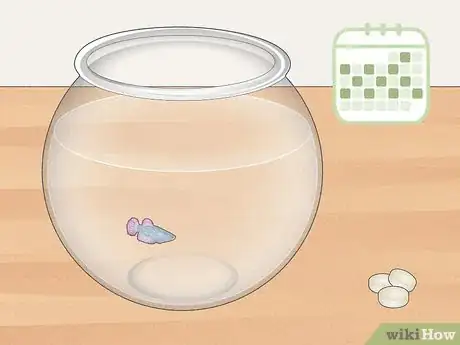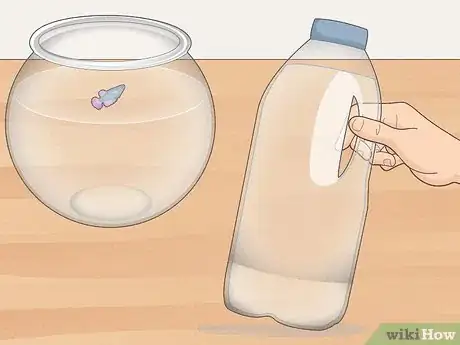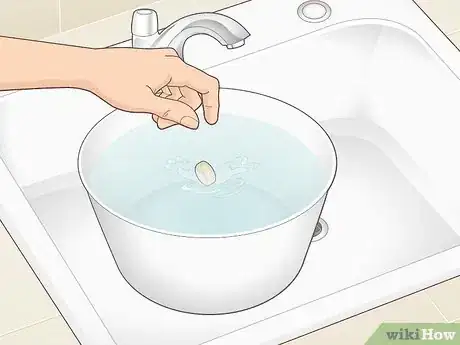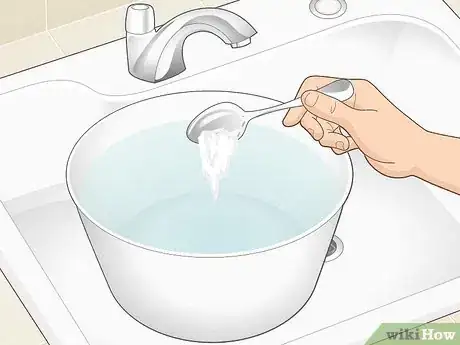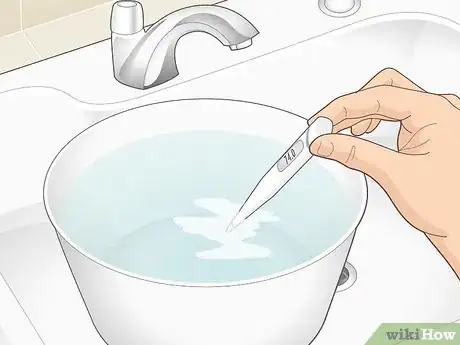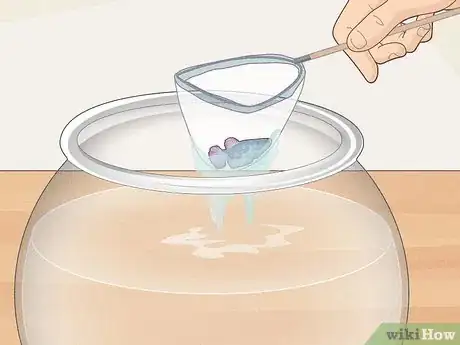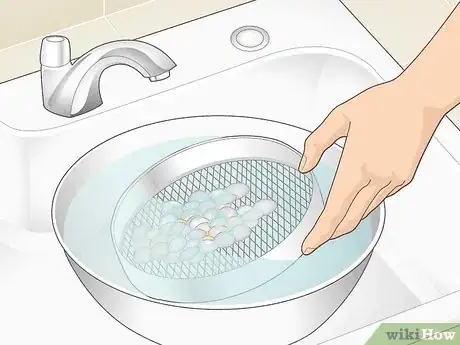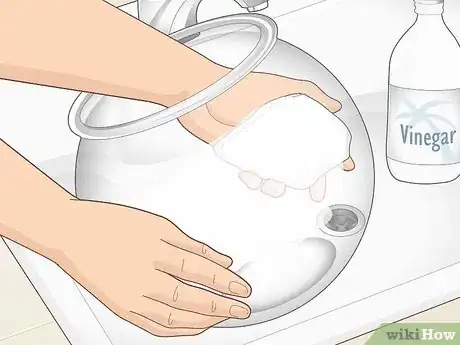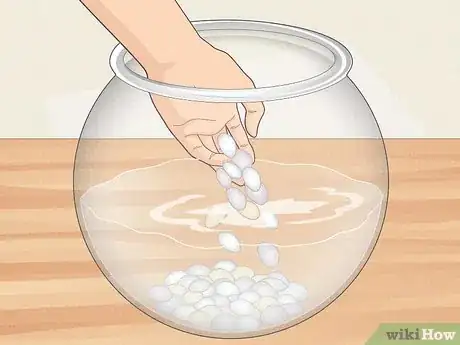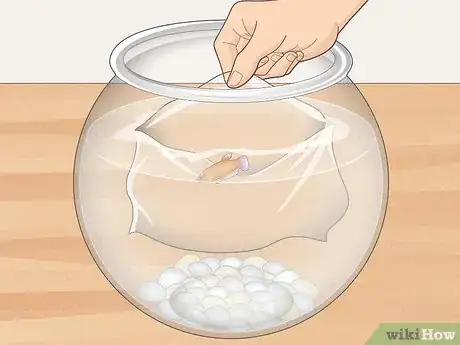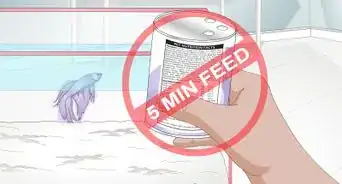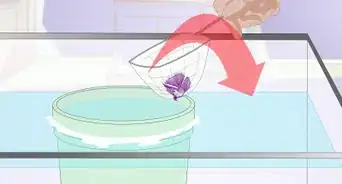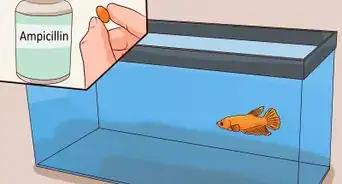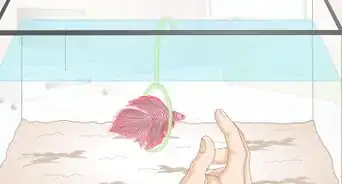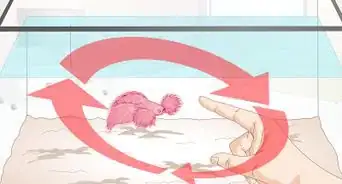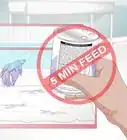This article was co-authored by Marshall Stephens. Marshall Stephens is an Aquarium Expert at Private Oceans Aquariums in West Palm Beach, Florida. Marshall has over 20 years of experience in the aquarium industry and focuses on captive-bred animals. They specialize in tropical and marine aquariums and are a contributor to the Loggerhead Marine life center in Jupiter Florida.
There are 8 references cited in this article, which can be found at the bottom of the page.
wikiHow marks an article as reader-approved once it receives enough positive feedback. In this case, several readers have written to tell us that this article was helpful to them, earning it our reader-approved status.
This article has been viewed 404,667 times.
Since betta fish get oxygen from the air, they can survive in a fish bowl without an aquarium filter. However, a small fish bowl can stress the betta fish and shorten its lifespan. Moreover, the bowl must be cleaned constantly, to keep it in top condition and to keep the ammonia levels down. The actual cleaning process is not difficult, as long as you know what to do, but investing in a tank or at least a large bowl will make cleaning safer and less tedious.[1]
Steps
Preparing to Clean
-
1Decide how often to clean the bowl. The main way to keep a fish bowl clean is to change some of the water in it. However, this process can stress or even kill the fish by disrupting the bacterial and chemical contents of the water. Follow this guide to keep your bowl contents healthy without changing the water unnecessarily often. Do also keep in mind that round containers such as bowls have been known to stress fish out and shorten their life. Yes, they can survive in a bowl, but they will not be truly happy. :[2]
- Clean 0.5 gallon (2 liter) bowls daily, 1.5 gal. (6 L) bowls three times a week, and bowls 3 gal. (12 L) and up twice a week. Ammonia levels rise quicker than you may know it.
- If your bowl has a filter, then you can cycle the bowl (which might be hard considering bowls are tiny and not humane), then you can clean the bowl once a week. Don't ever clean the bowl once a month. If the bowl is big enough, then you can keep the betta fish in the bowl while you clean it and change 50% of the water. Doing that will help the betta fish to not be stressed. There are not a lot of filter options for small fish tanks, so they usually require more frequent upkeep than large fish tanks.
-
2Choose new water. During the cleaning and water change, you'll remove about 20%–25% of the water in your fish bowl. The replacement water should be prepared at least 30 minutes in advance, to allow time for treatments to work. You may use tap water, distilled water, or rainwater, but be sure to follow the advice below to make it safe for your betta. Leave this out at room temperature in a clean, soap-free container while you clean the tank.
- Do not use rainwater in an area with acid rain.
Advertisement -
3Add a dechlorinator to tap water. This is sold at pet stores as "dechlorination tablets" or "water conditioner," and are used to break down chlorine and other chemicals harmful to fish. Add this to the tap water, following the instructions to treat the amount of new water you are adding. This usually takes at least 30 minutes to take effect.[3]
- Skip this step if using distilled water or rainwater.
-
4Add aquarium salt (optional). Aquarium salt for betta fish or goldfish can be added but is never recommended for long term use. Aquarium salt is not in fish's wild habitat, so is not recommended. This step is only recommended if the water in the bowl is 100% distilled water.[4]
-
5Check the temperature. Betta fish are tropical fish, and prefer temperatures around 74–82–F (23-28ºC), or just a little warmer than "room temperature." If the new water is not near this temperature, or if it feels colder or warmer than the water in the fishbowl, leave it in a warm room until it reaches a safe temperature.[5]
Cleaning a Betta Fish Bowl
-
1Wash your hands with plain water. Wash your hands to remove traces of dirt and soap before cleaning the tank. Do not use soap to wash your hands, as soap can harm or kill your fish.[6]
-
2Move the betta if the bowl is small. Leaving the betta in the tank is usually best for the fish. However, if the fish bowl is too small to easily reach in and clean without hitting the fish or blocking its access to the air, move the fish before cleaning. Transfer some water from the fish bowl to a clean, soap-free container, then use a fishnet to transfer the betta.[7]
- Leave at least 3 inches (7.5 centimeters) of space above the water level in the new container, so the betta cannot jump out.
-
3Scrub the inside with a brand new sponge or cloth. Even tiny traces of soap or other substances can harm your fish. Use a brand new sponge, or a cloth that has recently been through a washing and rinsing cycle and not used for any purpose since then. Rub the inside of the bowl in circular motions to remove slime and dirt.
- A sponge attached to a handle may be the easiest tool to use.
- You can use the same sponge to clean off rocks and other decorations too.
-
4Remove 20% of the fish bowl water. Use a siphon, bucket, or cup, making sure the tool is clean and soap-free, to remove about a fifth of the water from the fish bowl. You may use this in the garden, or dump it down a drain.
-
5Clean the outside with a different tool (optional). If the outside of the bowl is dusty or grimy, you may clean it with any ordinary sponge or cloth. You may use Windex, soap, or other cleaning products, as long as you are careful not to let any of it drip inside the bowl.
-
6Add the new water to the bowl. Only use water carefully selected or prepared with the instructions in the preparation section. If the fish is in the bowl, pour the water in slowly to avoid disturbing the fish with strong currents.
-
7Return the betta to the bowl. If you removed the betta fish for cleaning, use a fishnet to transfer it back into the bowl. If you are worried that the water temperature has changed, or if you accidentally changed more than 50% of the water, instead transfer the fish and the water it's swimming in to a small plastic bag. Float this bag on the surface of the bowl for 15–20 minutes, then let the fish swim into the bowl and remove the bag.
Performing a Major Clean
-
1Use this method only when absolutely necessary. You do not need to do a major cleaning unless the bowl has developed slime or grime you cannot scrub off, or if the water has become permanently cloudy. The more involved the cleaning is, and the more water you replace, the more stressed your fish will be. If the fish bowl is an adequate size for your betta fish, at least 3 gal. (6 L), you will only need to clean it this way once or twice a year.
-
2Prepare a new container of water. You'll be replacing about 50% of the water in the fish bowl. Use tap water treated with dechlorination tablets, freshly collected rainwater, or distilled water treated with aquarium salts. Check the water temperature to make sure it matches the water in the fish bowl.
- See the preparation section for more information on preparing aquarium water.
-
3Transfer half the water and the betta to another container. Move roughly 50% of the water in the fish bowl to another container. Even if the water looks filthy, do not transfer your betta to a container of new water. The shock could kill it.
- Keeping the old water also insures that you will still have useful bacteria in your fish bowl, which will break down otherwise harmful chemicals produced by your fish's waste.
-
4Empty the fish bowl. Separate out any gravel, pebbles and decorations by pouring the water through a sieve standing on a bucket, or by scooping them out with a cup. Dump the remaining water into your garden or down a drain. If your bowl is too heavy to handle easily, use a siphon hose instead to transfer the water to a bucket in stages.[8]
-
5Rinse the contents twice. Rinse all gravel, pebbles, and decorations once in a basin of hot water to remove as much grime as possible. Pour out the hot water and rinse a second time in cool or room temperature water. Rub them with your fingers or your dedicated aquarium sponge while rinsing the second time.[9]
-
6Scrub the fish bowl with vinegar if necessary. If water and elbow grease alone won't remove the gunk on the fish bowl, wet a cloth with white vinegar and scrub the sides. Always thoroughly rinse the vinegar in room temperature water after the fish bowl is clean.[10]
- Never use any soap, cleaning products, or any substance besides water or vinegar to clean your fish bowl.
-
7Set up the fish bowl again. Return the gravel, pebbles, and/or decoration to the fish bowl. Pour in the newly prepared water. Pour in most of the old water, but leave enough in the temporary container for your betta to swim. Wait for the clouds and gravel to subside to the bottom if necessary.
-
8Return the betta fish to its bowl. Because of the major changes to the bowl, introducing your fish slowly is recommended. Float the betta fish and the water it's been swimming in inside a small plastic bag, on top of the bowl water. After 15 minutes, pour a little of the bowl water into the bag. After 30 minutes, let the betta swim out of the bag into the rest of the bowl, and remove the bag.
Community Q&A
-
QuestionWhy does my betta only stay in one spot?
 CaeiiaTop AnswererIt might be cold, sick (check for hyperventilating, swollen belly, sudden dull colors, and lack of appetite), or bored.
CaeiiaTop AnswererIt might be cold, sick (check for hyperventilating, swollen belly, sudden dull colors, and lack of appetite), or bored. -
QuestionWhat happens if I've been changing all the water every time and putting in completely new water?
 Community AnswerMake sure it is the same temp each time you change it, because it can stress out the fish. If you take out the fish, get a container and put the old water in it.
Community AnswerMake sure it is the same temp each time you change it, because it can stress out the fish. If you take out the fish, get a container and put the old water in it. -
QuestionCan I use bottled drinking water?
 Community AnswerNo. Bottled water is treated with the same chemical (chlorine) as tap water. As an alternative to using conditioner or dechlorinator to make the tap water safe, you can put the water out in a open container overnight. This allows the chlorine to evaporate, making the water safe.
Community AnswerNo. Bottled water is treated with the same chemical (chlorine) as tap water. As an alternative to using conditioner or dechlorinator to make the tap water safe, you can put the water out in a open container overnight. This allows the chlorine to evaporate, making the water safe.
Warnings
- Soap can harm or kill your fish. Do not use it.⧼thumbs_response⧽
- It is not a good idea to keep bettas in a bowl, as they need proper filtration, a heater, plants, places to hide, and adequate swimming room. The minimum aquarium size for a betta is 5 gallons. 10 gallons is recommended since, in the wild, they can claim up to 300 gallons of water all to themselves!⧼thumbs_response⧽
- Bowls should be a TEMPORARY enclosure for a fish. Betta fish need a minimum of 2.5 gallons. Bowls should never be a permanent habitat.⧼thumbs_response⧽
References
- ↑ https://bettafish.org/faq/do-betta-fish-need-a-filter/
- ↑ https://www.petmd.com/fish/care/evr_fi_how-to-take-care-of-betta-fish
- ↑ http://www.bettaboxx.com/betta-care/betta-fish-water-use-not-use-test/
- ↑ https://www.ibcbettas.org/aquarium-salt-the-healthy-preventative-v-2-0/
- ↑ https://www.petsmart.com/learning-center/fish-care/betta-fish-care-guide/A0188.html
- ↑ https://www.petmd.com/fish/care/evr_fi_how-to-clean-fish-tank
- ↑ http://www.bettaboxx.com/betta-tanks/how-to-clean-betta-fish-tank/
- ↑ http://www.bettaboxx.com/betta-tanks/how-to-clean-betta-fish-tank/
- ↑ http://www.bettaboxx.com/betta-tanks/how-to-clean-betta-fish-tank/
About This Article
When it’s time to clean your betta fish bowl, leave the betta in the tank, but make sure you do not get any soap in the tank or the fish may die. To accomplish that, start by rinsing your hands off with plain water. Then, use a new, clean sponge or cloth to scrub the inside of the tank, and then use a soap-free cup or siphon to remove 20-25% of the tank’s water. Now that the bowl is clean, let some distilled water come to room temperature and pour it into the tank. To learn how to remove the betta and deep clean the tank, scroll down!
